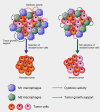M1 macrophages - unexpected contribution to tumor progression
- PMID: 40821768
- PMCID: PMC12350380
- DOI: 10.3389/fimmu.2025.1638102
M1 macrophages - unexpected contribution to tumor progression
Abstract
The anti-tumor role of the immune system has long been associated with interferon-γ-mediated activation of immune cells and their ability to recognize and eliminate transformed cells. Fundamental principles of tumor immunoediting describe a dynamic interplay between the immune system and neoplastic cells, wherein immune pressure can paradoxically shape tumor evolution. Within this context, macrophages, natural killer cells, and T lymphocytes are central effectors of anti-tumor immunity. Traditionally, macrophages exhibiting M1 phenotype are characterized by high cytotoxic potential and considered important contributors to tumor eradication. In contrast, M2-polarized tumor-associated macrophages are associated with immune suppression and tumor progression. However, recent evidence challenges this binary paradigm. It is increasingly evident that M1 macrophages, while initially exerting anti-tumor effects, can also promote tumor progression by applying sustained cytotoxic pressure that selects for more malignant and immune-resistant tumor clones. This phenomenon represents an unexpected and overlooked contribution of cytotoxic macrophages to tumor progression. In this review, we examine the complex, context-dependent function of M1 macrophages and reassess current strategies aimed at enhancing their cytotoxicity. While such approaches may offer short-term benefits, they risk driving clonal selection of aggressive, immune-evasive tumor cells. Therefore, we propose a paradigm shift: instead of promoting M1 polarization alone, therapeutic strategies should consider the broader consequences of macrophage-tumor interactions. A nuanced understanding of macrophage plasticity and tumor dynamics is essential for designing effective immunotherapies. Recognizing the paradoxical role of M1 macrophages is critical to avoiding unintended support of tumor evolution and improving treatment outcomes.
Keywords: ADCC; ADCP; immunotherapy; inflammation; innate immunity; macrophage; tumor.
Copyright © 2025 Kovaleva, Rashidova, Sinyov, Malashenko and Gratchev.
Conflict of interest statement
The authors declare that the research was conducted in the absence of any commercial or financial relationships that could be construed as a potential conflict of interest. The author(s) declared that they were an editorial board member of Frontiers, at the time of submission. This had no impact on the peer review process and the final decision.
Figures

Similar articles
-
Prescription of Controlled Substances: Benefits and Risks.2025 Jul 6. In: StatPearls [Internet]. Treasure Island (FL): StatPearls Publishing; 2025 Jan–. 2025 Jul 6. In: StatPearls [Internet]. Treasure Island (FL): StatPearls Publishing; 2025 Jan–. PMID: 30726003 Free Books & Documents.
-
Nanomaterials in modulating tumor-associated macrophages and enhancing immunotherapy.J Mater Chem B. 2024 May 22;12(20):4809-4823. doi: 10.1039/d4tb00230j. J Mater Chem B. 2024. PMID: 38695349 Review.
-
Chemoradiation-Altered Micromilieu of Glioblastoma Cells Particularly Impacts M1-like Macrophage Activation.Int J Mol Sci. 2025 Jul 8;26(14):6574. doi: 10.3390/ijms26146574. Int J Mol Sci. 2025. PMID: 40724825 Free PMC article.
-
Spatio-Temporal Dynamics of M1 and M2 Macrophages in a Multiphase Model of Tumor Growth.Bull Math Biol. 2025 Jun 4;87(7):92. doi: 10.1007/s11538-025-01466-6. Bull Math Biol. 2025. PMID: 40464993 Free PMC article.
-
Management of urinary stones by experts in stone disease (ESD 2025).Arch Ital Urol Androl. 2025 Jun 30;97(2):14085. doi: 10.4081/aiua.2025.14085. Epub 2025 Jun 30. Arch Ital Urol Androl. 2025. PMID: 40583613 Review.
References
-
- Sanchez-Reyes K, Bravo-Cuellar A, Hernandez-Flores G, Lerma-Diaz JM, Jave-Suarez LF, Gomez-Lomeli P, et al. Cervical cancer cell supernatants induce a phenotypic switch from U937-derived macrophage-activated M1 state into M2-like suppressor phenotype with change in Toll-like receptor profile. BioMed Res Int. (2014) 2014:683068. doi: 10.1155/2014/683068, PMID: - DOI - PMC - PubMed
Publication types
MeSH terms
LinkOut - more resources
Full Text Sources
Medical

